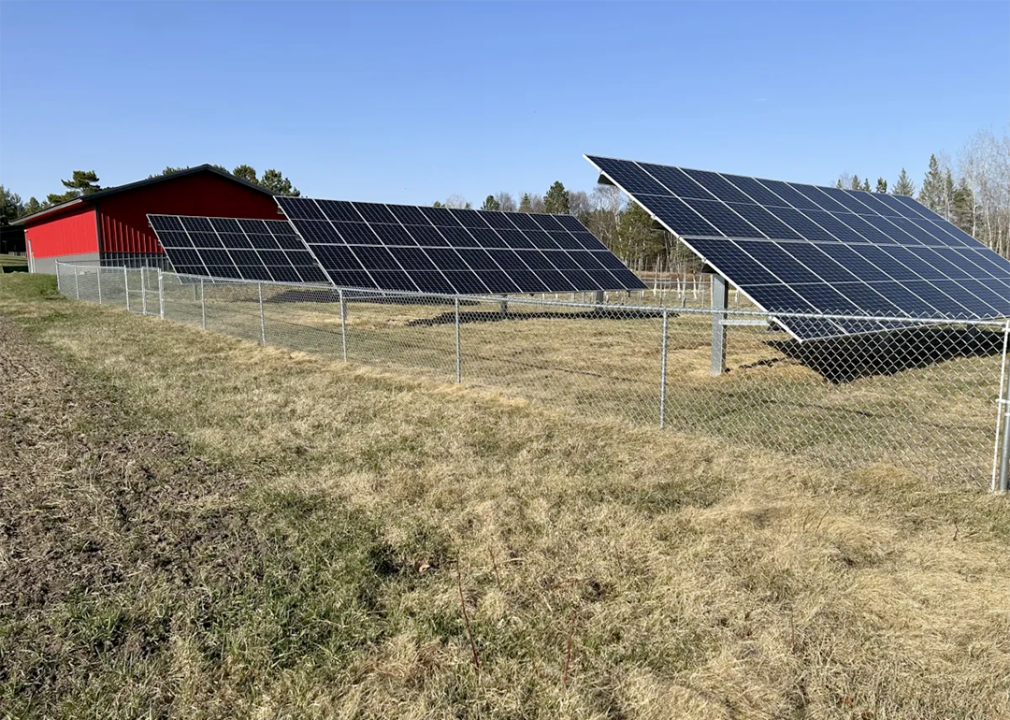
Up until a few years ago, when people visited Lavalier's Berry Patch outside Grand Rapids, Minnesota, to pick strawberries, lingonberries, and apples, Stuart Lavalier would tell them to look for a red building next to County Road 91 to find the turn-off to his farm.
Now, he tells them to look for the solar panels.
In early 2022, Lavalier received a $17,000 federal grant to install three solar arrays that make 27 kilowatts of electricity, enough to power his entire farm.
Lavalier is one of thousands of rural small business owners and agricultural producers to benefit from the Rural Energy for America Program (REAP), which provides grants and loan guarantees for energy efficiency and renewable energy projects. Lavalier got his grant in 2022. Since then, the Inflation Reduction Act provided the program an extra $2 billion to pay for projects through 2031.
But even though the number of projects funded has increased in the past year-and-half since the expansion, in fiscal year 2023 fewer awards were given to small-scale projects than in previous years, according to an internal analysis from the Environmental Law and Policy Center.
"What we've seen in the past is that this was flipped and that the most [awards] were going to the smallest projects," said Andy Olsen, senior policy advocate at the Environmental Law and Policy Center (ELPC), in an interview with The Daily Yonder. He leads the organization's Farm Bill clean energy and rural solar programs.
"Under the Inflation Reduction Act, now we've got this situation where the highest number [of grants] is going to the largest projects," Olsen said.
The USDA Rural Development office that administers REAP categorizes projects into three tiers: Tier one for projects $80,000 and below, tier two for projects $81,000-$200,000, and tier three for projects larger than $200,000. USDA is required to set aside at least 20% of REAP funds for small-scale grants of $20,000 or less because of a stipulation created in the 2008 Farm Bill.
And for the past decade they've far exceeded this requirement. Between fiscal years 2014 and 2022, just over 7,500 projects were awarded grants and loan guarantees, according to USDA data. Almost 47% of REAP grants and loan guarantees went to small-scale projects that cost under $80,000, according to an ELPC analysis of USDA data. About 21% went to the largest projects that cost more than $200,000.
But in fiscal year 2023, approximately 3,000 projects were awarded REAP money, but nearly half of the awards went to projects that would cost more than $200,000 to implement, according to the ELPC analysis. Just over 30% of grants went to mid-size projects, and just under 25% went to the smallest projects.
Policy advocates say that funding smaller projects can be most beneficial to rural small businesses and farmers struggling to stay afloat than larger corporations. Funding smaller renewable energy projects can also help disrupt monopoly utilities that have wiped out competitors in order to maximize profit, according to Olsen.
The number of large-scale grants awarded in fiscal year 2023 could be because of a new technical assistance grant program that producers, agencies, and small businesses can apply for to fund feasibility studies or grant writers to help with a REAP grant application, Olsen said. Most of the fiscal year 2023 technical assistance grants were over $200,000 because they went to big-ticket items like people's salaries.
"Hopefully the new Technical Assistance Grants issued in 2023 will return support for smaller projects and operators to REAP," Olsen said.
Another reason could be that the USDA is prioritizing larger projects because it has one decade to distribute $2 billion. "I think just in terms of trying to do that and trying to manage all those applications, a smaller number of applications is easier than a larger number of applications," Olsen said. "And so it's just the bigger projects [USDA] was able to [fund]."
In response to why more large projects were funded in fiscal year 2023, the administrator of USDA's Rural Development's Rural Business Cooperative Service Betsy Dirksen Londrigan emphasized that the Inflation Reduction Act increased the percentage of a project a REAP grant can fund. Before the expansion, USDA could only pay up to 25% of a project's total cost. Now, they can grant up to 50% of the total project cost.
"With the Inflation Reduction Act funds, a really wonderful change that we've been able to make is that we have been able to increase the amount that we can grant," Londrigan said in a Daily Yonder interview. " I think what you're seeing is it's opening the door to so many more people."
Regardless of which size projects have been prioritized since the Inflation Reduction Act expansion, policy advocates and USDA officials can agree on one thing: Rural America is seeing a monetary and environmental boon from the influx of renewable energy funding.
"The thing that's so exciting about this is that it is putting money back in their pockets and allowing them to make more decisions about their business, about their farm, about their family, and it's helping to combat climate change while doing it," Londrigan said.
This is certainly the case for Minnesota farmer Stuart Lavalier who, since installing the three solar arrays on his property, has received on average $300 back each month from the local power company because of the excess power his solar panels generate.
"We're hoping that maybe a 10-year commitment, maybe a little bit less, and the solar [arrays] should be paid for," Lavalier said. In the meantime, he's thinking about putting chickens and sheep in the fenced area where his solar panels are so visitors to his farm can learn about renewables and see animals all at the same time.
The REAP application period is open quarterly and interested applicants should go to their state offices for support. The current application window is now to Sept. 30, 2024.
This story was produced by The Daily Yonder and reviewed and distributed by Stacker Media.